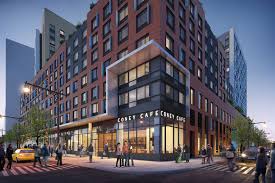Coney Island might be famous for its roller coasters, boardwalk fries, and that legendary hot dog eating contest—but now, it’s about to get a brand-new identity: home to one of New York City’s latest affordable housing projects.
City officials have announced plans to build more than 1,100 new housing units just blocks away from the beachside bustle.
And while some are cheering the effort to tackle NYC’s housing crunch, others in the neighborhood aren’t exactly rolling out the welcome mat.
New Apartments Just Steps from the Sand
The development will bring 720 affordable units to the southern tip of Brooklyn, an area where the scent of funnel cakes fills the air and amusement rides still clatter along century-old tracks.
One of the new buildings will offer one-bedroom apartments at around $1,800 a month—well below the current Brooklyn average.
To put that in perspective, renters signing new leases in July saw the median price for a 545-square-foot apartment soar past $2,800 a month.
In Coney Island specifically, the average rent is now above $3,200.
So yes, $1,800 is a deal by New York standards.
Not Everyone’s Thrilled by the Plan
Still, not all locals are excited about the change.
Some worry the neighborhood’s already overwhelmed infrastructure might not keep up.
“People joke, ‘Don’t have a heart attack on the Fourth of July—it’ll take two hours for an ambulance to get to you,’” said Angela Kravtchenko, vice chair of the local land use committee, speaking to Gothamist.
Between heavy traffic, limited roadways, and emergency services already stretched thin during the summer surge, concerns about congestion aren’t just urban myths—they’re lived reality for many residents.
Mayor Adams’ Big Housing Gamble
The new Coney Island project is just one piece of Mayor Eric Adams’ larger “City of Yes” initiative.
That sweeping plan aims to cut through red tape, modernize zoning laws, and build more housing in a city where demand continues to skyrocket.
The Adams administration claims it has achieved two straight years of record-breaking home construction.
The Coney Island development, they argue, is another step in the right direction to address a chronic housing shortage.
But critics say the city’s growth strategy isn’t balancing public infrastructure or climate threats—especially in flood-prone areas like this one.
Flood Risks and Climate Concerns
Environmental advocates have also raised red flags.
A survey by Hofstra University predicts that most of Coney Island will face increased flooding in the next decade due to sea-level rise.
That has sparked concerns over whether it’s wise to build more housing in an area expected to be increasingly vulnerable to climate change.
Yet despite the warnings, the Mayor’s office is pushing forward with the project, arguing that affordable housing is too important to delay.
Traffic, Tolls, and Transit Trouble
Some locals fear the development will only worsen traffic woes.
Coney Island’s narrow streets already feel the pinch—especially during summer weekends.
And while Manhattan’s congestion pricing plan charges drivers a $9 toll to enter the busiest areas below Central Park, no such system exists for Brooklyn.
That’s left some wondering whether similar tools should be used in outer boroughs to ease the impact of new developments on roads and emergency access.
Housing and Hot Dogs on the Horizon
Despite the backlash, the project is expected to be a cornerstone of Mayor Adams’ re-election campaign.
His team is betting that new homes—especially affordable ones—will resonate with New Yorkers struggling to find a place to live.
And for future residents of Coney Island? Living next door to Nathan’s Famous might be an added perk.
If you’ve got a strong stomach, you may even be able to train for the annual hot dog eating contest just steps from home.

